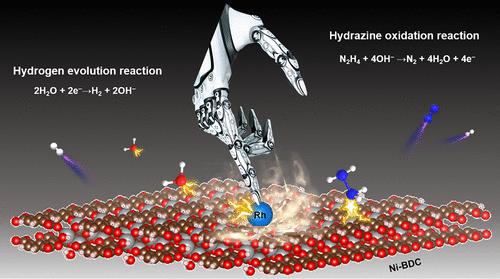Our official English website, www.x-mol.net, welcomes your
feedback! (Note: you will need to create a separate account there.)
Leveraging Metal Nodes in Metal–Organic Frameworks for Advanced Anodic Hydrazine Oxidation Assisted Seawater Splitting
ACS Nano ( IF 15.8 ) Pub Date : 2023-06-01 , DOI: 10.1021/acsnano.3c02749 Xuefei Xu, Hsiao-Chien Chen, Linfeng Li, Muhammad Humayun, Xia Zhang, Huachuan Sun, Damien P. Debecker, Wenjun Zhang, Liming Dai, Chundong Wang
ACS Nano ( IF 15.8 ) Pub Date : 2023-06-01 , DOI: 10.1021/acsnano.3c02749 Xuefei Xu, Hsiao-Chien Chen, Linfeng Li, Muhammad Humayun, Xia Zhang, Huachuan Sun, Damien P. Debecker, Wenjun Zhang, Liming Dai, Chundong Wang

|
Metal–organic frameworks (MOFs) show great promise for electrocatalysis owing to their tunable ligand structures. However, the poor stability of MOFs impedes their practical applications. Unlike the general pathway for engineering ligands, we report herein an innovative strategy for leveraging metal nodes to improve both the catalytic activity and the stability. Our electrolysis cell with a NiRh-MOF||NiRh-MOF configuration exhibited 10 mA cm–2 at an ultralow cell voltage of 0.06 V in alkaline seawater (with 0.3 M N2H4), outperforming its counterpart benchmark Pt/C||Pt/C cell (0.12 V). Impressively, the incorporation of Rh into a MOF secured a robust stability of over 60 h even when working in the seawater electrolyte. Experimental results and theoretical calculations revealed that Rh atoms serve as the active sites for hydrogen evolution while Ni nodes are responsible for the hydrazine oxidation during the hydrazine oxidation assisted seawater splitting. This work provides a paradigm for green hydrogen generation from seawater.
中文翻译:

利用金属有机框架中的金属节点进行高级阳极肼氧化辅助海水分解
金属有机框架 (MOF) 由于其可调的配体结构,在电催化方面显示出巨大的潜力。然而,MOFs 较差的稳定性阻碍了它们的实际应用。与工程配体的一般途径不同,我们在此报告了一种利用金属节点来提高催化活性和稳定性的创新策略。我们的电解槽采用 NiRh-MOF||NiRh-MOF 配置,在碱性海水(含 0.3 MN 2 H 4),优于其对应的基准 Pt/C||Pt/C 电池 (0.12 V)。令人印象深刻的是,即使在海水电解质中工作,将 Rh 掺入 MOF 也能确保超过 60 小时的稳健稳定性。实验结果和理论计算表明,在肼氧化辅助海水分解过程中,Rh 原子是析氢的活性位点,而 Ni 节点负责肼氧化。这项工作为从海水中产生绿色氢提供了范例。
更新日期:2023-06-01
中文翻译:

利用金属有机框架中的金属节点进行高级阳极肼氧化辅助海水分解
金属有机框架 (MOF) 由于其可调的配体结构,在电催化方面显示出巨大的潜力。然而,MOFs 较差的稳定性阻碍了它们的实际应用。与工程配体的一般途径不同,我们在此报告了一种利用金属节点来提高催化活性和稳定性的创新策略。我们的电解槽采用 NiRh-MOF||NiRh-MOF 配置,在碱性海水(含 0.3 MN 2 H 4),优于其对应的基准 Pt/C||Pt/C 电池 (0.12 V)。令人印象深刻的是,即使在海水电解质中工作,将 Rh 掺入 MOF 也能确保超过 60 小时的稳健稳定性。实验结果和理论计算表明,在肼氧化辅助海水分解过程中,Rh 原子是析氢的活性位点,而 Ni 节点负责肼氧化。这项工作为从海水中产生绿色氢提供了范例。















































 京公网安备 11010802027423号
京公网安备 11010802027423号